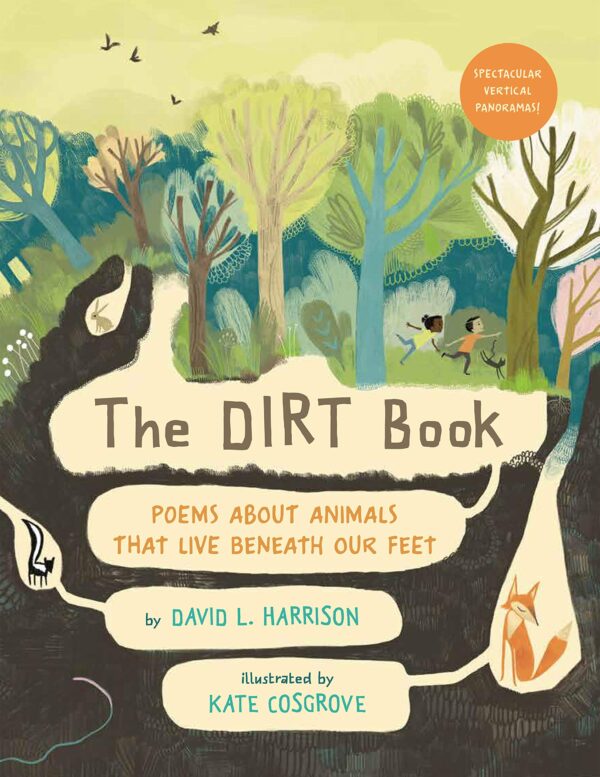When panoramic photography became a thing in the mid-90s I was a big fan and used it often. One day I was with some friends exploring a mountainous area and turned my panoramic camera so that I was using it in a portrait manner. This allowed the massive contrasts of the mountains to share some of the images with the depths of the river. The Dirt Book brings us back to that memory because it’s presented in vertical panoramas. That design, as well as, the exceedingly clever manner in which the poetry complements the art will bring young readers into a world that they see every day but don’t think about too often.

The Dirt Book starts with a middle-elementary description of the five W’s about it. It presents the subject matter and asks the questions in a way that all elementary school students process things. How old is dirt? Where does dirt come from and many more are posed in the introduction, but not answered.
Answering them directly in a textbook fashion is the sort of knowledge that will be dropped on them in middle school, science class. This is STEM through discovery, curiosity, critters, and art. It’s the best sort of STEM because kids will want to read it because it’s fun and effortless to engage in. Will young readers actually learn anything from The Dirt Book? Yes, but don’t tell them that and don’t sell to book to them as an exercise in nature studies.
All you have to do is read the poems and have them fill in the blanks with their imagination. The poems vary in length, with the longest ones being 20 or so stanzas, with about five words in each line. This is important because older readers, those in third grade and up (way up), might be averse to poetry. For the record, I completely lay blame for that fact at the feet of The Raven and certain ages being required to memorize it.
The Dirt Book proves that poetry can be something that younger aged elementary school students can enjoy. The words buzz with excitement, and illustrate the peace, mystery, and sometimes danger that might menace its prey from below. The doodlebug is a particularly fearsome critter. I’ve never heard of it, but this coconut-shaped bug makes an underground funnel, with its sides being smooth. Ants will come along, start walking down the funnel, and eventually make their way into the belly of the Doodlebug.
Each pair of pages offers a different discussion for young audiences to jump off into. The poem about yellow jacket wasps is very short but opens things up to some very obvious questions from young readers. Are above-ground and underground nests the same? Have you ever seen one? What should you do if you see one? These are the talking points that could follow you after you read it. If your audience is slightly older then they can read the paragraph at the end of the book that presents data on the page in a more narrative manner.
The scale of the book will also draw kids in. The earthworm is a small creature. However, when the vertically oriented pages show earthworms that are in scale with their tunnels and habitat, it’s a different feeling. Readers really get a sense of wonder those creatures and appreciation for the seemingly mundane things that they accomplish. Big deal an ant made a tunnel. Yeah, but look at the byzantine way their trails look, remembering that they can’t use words but are able to lift 60 times their weight, and you’ve got an action/adventure escapade that’s playing out just under our feet.
Some kids might think like that. Some other kids might simply dig the poetry, and then mildly think about the things that spill out from the ground into the street when it rains, while others might have been stung by them or seen traces of their presence. The Dirt Book gets kids in kindergarten and up thinking about the grassy or muddy areas that they walk in during the warm months. The poetry will bring in some kids as the read-along nature is very soothing. Those older kids who are into poetry will dig the book because of the calming way in which it makes them chill out and think. Educators and parents will like it because the book is one that works as a great, good-night book, or as one that they can read by themselves.
The Dirt Book, Poems About Animals That Live Beneath Our Feet is by David L. Harrison with illustrations by Kate Cosgrove and available on Holiday House Books.
There are affiliate links in this post.





 Facebook
Facebook Twitter
Twitter Flickr
Flickr GooglePlus
GooglePlus Youtube
Youtube